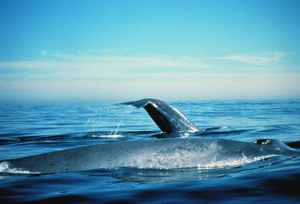Marine Mammal Species Description
Blue Whale
Balaenoptera musculus
(Linnaeus, 1758)

Photo credit: Dan Shapiro, NOAA Photo Library
Classification
Order: Cetacea
Family: Balaenopteridae
Alternate Common Names: Sulfur-bottom, Sibbald's rorqual, great blue whale, great northern rorqual
Status: ESA Endangered/ MMPA Depleted
Description:
Length: 72-92 ft (22-28 m) in the northern hemisphere
Weight: 141,100 lbs (64,000 kg) in the northern hemisphere
Blue whales are the largest animals on Earth. A southern hemisphere blue whale was measured 108 ft (33.6 m) in length and weighing 418,900 lbs (190,000 kg). They have a 'U' shaped head when viewed from above, and a very small falcate dorsal fin located nears its tail. They have a single ridge down the center of their rostrum. On their throats to their naval, blue whales have 55-88 ventral grooves or pleats. These whales are in the suborder Mysticeti, or the baleen whales. Baleen whales do not have teeth, but have plates attached to their upper jaws. These baleen plates are hard, but flexible, which baleen whales use to filter their food from the water. Blue whales are bluish-gray or black overall, with gray mottling on their backs, sides, bellies, and are lighter underneath. They occasionally have diatoms living on their undersides giving them an orange, brown, or yellow tinge on their bellies.
Habitat:
Blue whales typically occur in the deep, open ocean. They may come closer to the coasts to feed and for breeding. Where they are around the world depends on where there are areas of high krill abundance. Blue whales typically occur by themselves or in groups of two or three animals. In areas where food is abundant, up to 50 or more whales may use the same area for feeding.
Feeding:
Blue whales eat mostly krill, a species of zooplankton. They feed by gulping or lunging. The ventral grooves on their throat allow their throat to expand and take in large amounts of water. They close their mouth and force the water out and strain the food with their baleen. During summer months, they can eat up to 4 tons of krill in a single day. They occasionally dive for up to 30 minutes while they are feeding.
Reproduction:
Most blue whales become sexually mature around 8-10 years of age, although some blue whales become sexually mature as early as 5 year old and as late as 15 years old. Sexually mature blue whales are about 66-75 ft (20-23 m) long. Females give birth to a single calf every 2-3 years. The gestation period is about 10-12 months. Females wean their calves after 6-8 months.
Other:
Scientists estimate the maximum life span of blue whales to be 80-90 years. Blue whales can swim at speeds of up to 30 miles per hour (48 km per hour) when they are being chased or are chasing other whales, but they most often travel at speeds of 3-19 miles per hour (5-30 km per hour).
Distribution / Range:
Blue whales occur worldwide. Some blue whales appear not to be migratory and others appear to be migratory. They tend to be seen in the polar extremes more often during the summer than at other times of the year.
Similar species:
The most similar species are fin and sei whales.
Notes:
References:
American Cetacean Society. 2004. American Cetacean Society Fact Sheet. http://www.acsonline.org/factpack/bluewhl.htm. Accessed January 2012.
Jefferson, T.A., S. Leatherwood, and M.A. Webber. 1993. FAO species identification guide. Marine mammals of the world. Rome, FAO. 320 p. 587 figs.
Potter, C.W. and B. Birchler. 1999. Blue whale, Balaenoptera musculus. In The Smithsonian Book of North American Mammals. Wilson, D.E. and S. Ruff, eds., 251-253. Smithsonian Institution in association with the American Society of Mammologists, Washington DC.
Reilly, S.B., Bannister, J.L., Best, P.B., Brown, M., Brownell Jr., R.L., Butterworth, D.S., Clapham, P.J., Cooke, J., Donovan, G.P., Urbán, J. & Zerbini, A.N. 2008. Balaenoptera musculus. In: IUCN 2011. IUCN Red List of Threatened Species. Version 2011.2. www.iucnredlist.org. Downloaded on 09 January 2012.
Sears, R. and W.F. Perrin. 2009. Blue Whale - Balaenoptera musculus. In: Encyclopedia of Marine Mammals 2nd Ed. Perrin W.F., B. Würsig, and J.G.M. Thewissen, eds. Academic Press, New York, pp. 120-124.

 Marine Mammals of Georgia
Marine Mammals of Georgia